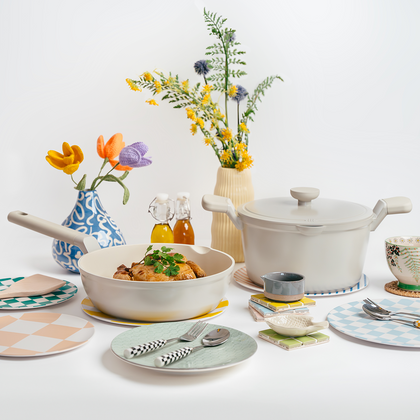
Nonstick cookware can be an absolute joy to cook with. Thanks to its smooth nonstick surface, cooking becomes a breeze and cleanup becomes a joy rather than a chore. However, amidst the convenience, you risk unintentionally damaging your beloved nonstick pots and pans. To ensure they maintain their peak performance and extended lifespan, avoid committing these common mistakes as we share tips and tricks on the proper usage and care when it comes to nonstick cookware.
Nonstick Cookware Care Guide
What is Nonstick Cookware?
Nonstick cookware is a type of kitchenware specially crafted to prevent food from adhering to the surface during cooking. The surface of these kitchen appliances is exceptionally smooth as they are coated with a nonstick layer. This ensures ease of use and cleanup, offering a hassle-free cooking experience.

Common Cooking Mistakes
Not Seasoning Your Nonstick Cookware
Oftentimes, the excitement of receiving new cookware can result in the immediate urge to use them straight away. However, to ensure their longevity, it is crucial to season your pots and pans before the first use and periodically thereafter.
Preheating Empty Cookware
It is a common practice to preheat your nonstick cookware on the stove before cooking. However, this method can be extremely detrimental to your nonstick pots and pans. Unlike stainless steel interior cookware, nonstick variants can’t withstand prolonged exposure to high temperatures without risking damage to their coating. A few minutes of continuous heating can result in your pots and pans reaching very high temperatures, causing the nonstick surface to degrade.
Cooking Over A High-Heat Setting
For optimal results with browning or searing, it might be tempting to turn up the heat of your nonstick cookware. However, this approach is not advisable with nonstick cookware. Continuous exposure to high amounts of heat will compromise the surface, resulting in surface discolouration and in severe cases, the nonstick coating peeling or blistering.
Using Sharp Or Abrasive Utensils
Stainless steel utensils, including metal tools, spoons, and whisks, can easily scratch the non-stick coating on your pots and pans. Despite claims of being “Metal Tool Compatible”, it is best to avoid doing so to prevent damage to the surface of your nonstick cookware.
Cleaning Your Nonstick Cookware In The Dishwasher
Using hot water and harsh detergents in dishwashers can accelerate the degradation process of your nonstick cookware. While many claim to be dishwasher safe, prolonged exposure to these conditions can expedite the breakdown of the nonstick coating on your pots and pans.
Before Cooking: Care Guide

Wash And Season
Prior to using your brand-new nonstick cookware, start by giving it a thorough rinse with hot, soapy water to remove any residue from the packaging. After drying it completely, season the pot/pan by lightly rubbing some cooking oil over the surface. Heat it over medium heat for two to three minutes on the stove. Once cooled, use a paper towel to wipe away any excess oil.
During Cooking: Care Guide
Choose The Right Utensils
Safeguard your cookware investment by selecting the appropriate utensils. Avoid using metal utensils that could potentially damage the nonstick coating. Opt for wooden spoons or silicone utensils instead as they lack sharp edges that could scratch the surface.
Avoid High Heat And Overheating
Never heat an empty pot or pan; always ensure there is oil, water or food present in the pot/pan before turning on the stove. When cooking, stick to low to medium heat settings to prolong the lifespan of your nonstick coating.
Do Not Use Nonstick Spray
Steer clear of using nonstick cooking sprays, as they tend to burn at a lower temperature compared to the nonstick coating itself. This discrepancy puts your cookware at a potential risk of being damaged. Using nonstick cooking sprays can also lead to residue buildup over time, compromising the surface of your nonstick cookware. Instead, opt for a small amount of oil or butter without risking damage to your nonstick cookware.

After Cooking: Care Guide
Hand Wash With Care
When it comes to cleaning your cookware, treat it with care to maintain its pristine condition. Avoid using abrasive tools such as steel wool, scouring pads, or stiff scrubbing brushes as they can scratch the surface. A gentle scrub with mild dish soap and a soft cloth or sponge should suffice.
For stubborn residue, soak the pot/pan in warm, soapy water for a few hours before gently scrubbing it clean. Alternatively, create a paste by mixing a small amount of baking soda and water, apply it to the surface and lightly scrub it with a non-abrasive sponge to remove the burnt oil or food. Rinse thoroughly, dry, and re-season your pan once more.

Proper Storage
Minimise the risk of damaging your cooking by avoiding stacking your cookware. Stacking pots and pans can result in scratches or chips on the cooking surface. If space limitations require you to stack them, place a layer of paper towels between each pot/pan to create a protective barrier.

With the proper use and care, your nonstick cookware is sure to last for years to come. Nevertheless, it is essential to acknowledge that nonstick cookware may require more frequent replacement compared to any other type of cookware. Consider opting for Pretty Major’s selection of nonstick pots and pans that feature a ceramic coating, ensuring superior quality and performance.





